Key points to remember: Shot-blasting, by projecting particles at high speed, strengthens metals and optimizes their adhesion. By creating compressive stresses, it triples or even increases tenfold the service life of critical parts (up to 1000% in aeronautics). Ecological, versatile and cost-effective, it is a mainstay of demanding industries such as automotive and wind power.
Can your metal parts withstand extreme stress without cracking or premature wear? Shot peening, a surface treatment process using high-speed shot blasting, transforms their lifespan by combining controlled work hardening and optimal coating preparation. Used in aeronautics for landing gear, in shipbuilding for reinforced hulls and in the automotive industry for suspension springs, shot peening combines mechanical strength, aesthetics and circular economy, thanks to abrasives that are 90% recyclable. By creating compressive stresses on the surface, it prevents the propagation of cracks and reduces replacement costs, while guaranteeing optimum adhesion for paints or anti-corrosion treatments.
- What is shot blasting and why use it?
- The blasting process: abrasives, methods and stages
- Concrete shot blasting applications by sector and material
- Blasting equipment and industry innovations
- Safety, standards and best practices for shot blasting
What is shot blasting and why use it?
Shot peening: a clear definition of the principle of surface peening
Shot-blasting is a surface treatment process involving the projection of metal, glass or ceramic particles at high speed (up to 100 m/s). This hammering action modifies the mechanical properties of the surface. Unlike sandblasting, which uses angular abrasives, shot blasting employs spherical beads to reinforce or prepare surfaces. Find out more about the difference between shot-blasting and sandblasting.
Main objectives: clean, prepare and strengthen
Shot blasting serves three key functions:
- Cleaning: Removal of rust, scale, old paint and foundry impurities.
- Preparation: Creation of an anchoring profile (controlled roughness) for optimum adhesion of coatings, reducing delamination.
- Reinforcement : Shotpeening induces residual compressive stresses. This improves fatigue resistance and extends the service life of critical parts.
Key benefits for the durability of your parts
Shot blasting optimizes industry and the environment thanks to :
- Extended service life: up to 10x more fatigue resistance for components subject to cyclic stress.
- Reliable adhesion: Controlled roughness limits paint peeling on exposed parts.
- Aesthetic finishes: flaw masking and satin-finish surfaces improve aesthetics.
- Reduced environmental impact: Metal shot can be recycled up to 100 times, limiting waste.
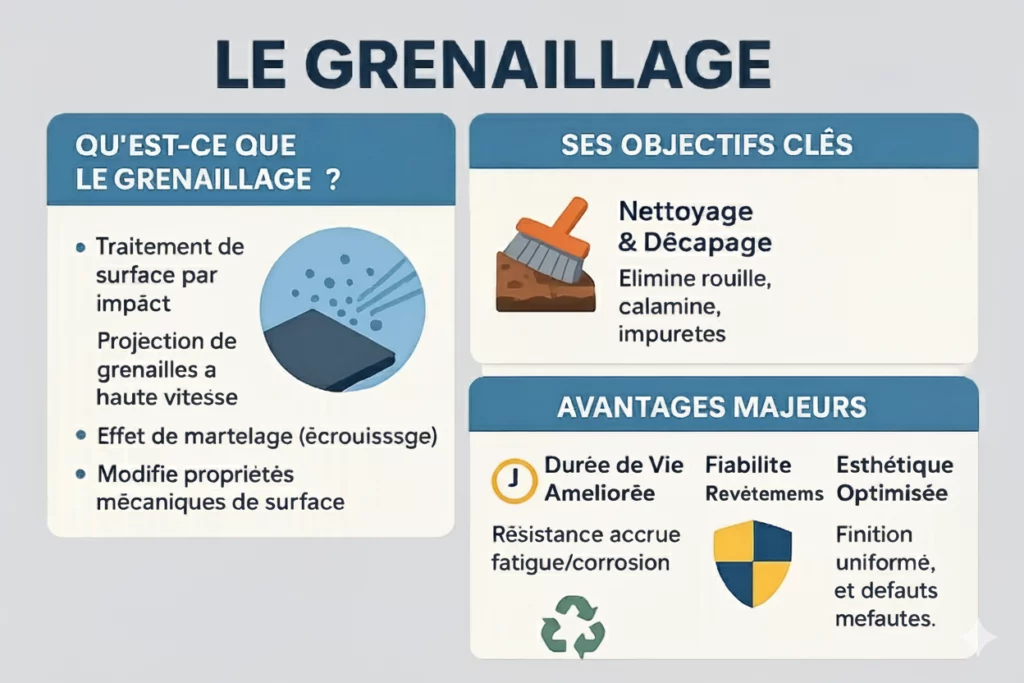
Combining cleaning, preparation and reinforcement, shot blasting is a versatile solution for the automotive, aerospace and energy industries. FINISHTECH machines guarantee industrial precision and optimum results for demanding applications.
The blasting process: abrasives, methods and stages
Choosing the right abrasive: the secret of successful shot-blasting
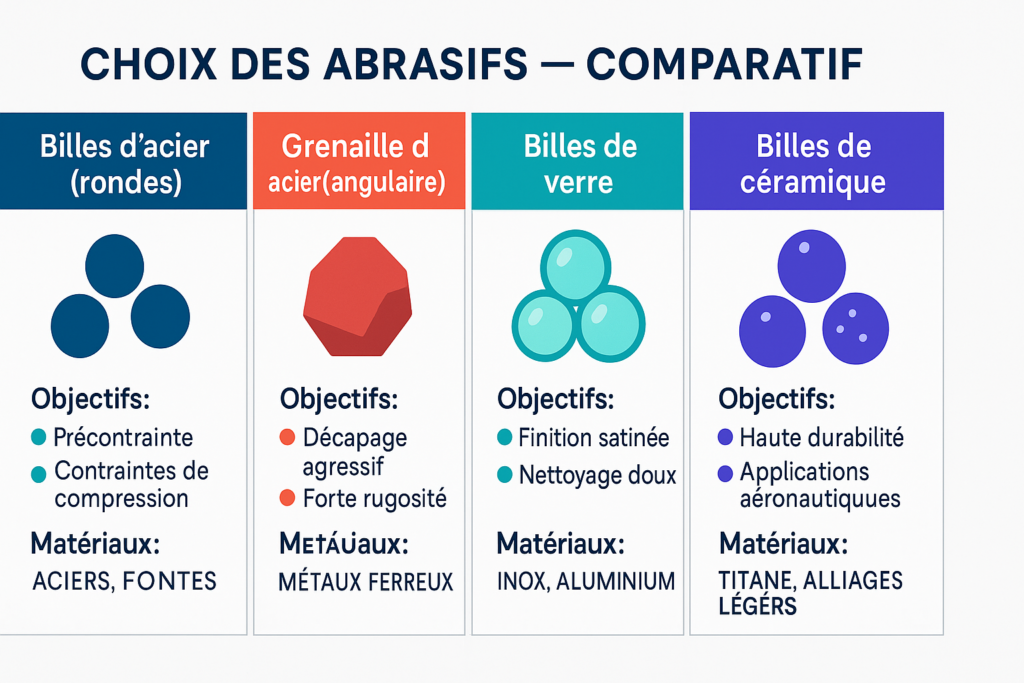
The type of abrasive used determines the quality of the treatment. Metallic abrasives, such as round steel beads, are ideal for shot peening, while angular abrasives act on roughness. Non-metallic abrasives, such as glass beads, treat delicate surfaces without alteration.
| Abrasive type | Main application | Surface effect | Compatible materials |
|---|---|---|---|
| Round steel shot | Shot peening | Creates compressive stress | Steels, Cast iron |
| Angular steel shot | Aggressive stripping | Creates high roughness | Ferrous metals |
| Glass bead | Satin finish | Smoothes and cleans | Stainless steel, Aluminium |
| Ceramic bead | Aeronautical applications | Very high wear resistance | Titanium, Light alloys |
Ceramic beads, with a hardness of 8 to 9 on the Mohs scale, offer a service life 3 to 5 times longer than glass beads. They reduce waste disposal costs by 40%, a crucial criterion for companies concerned about their environmental impact.
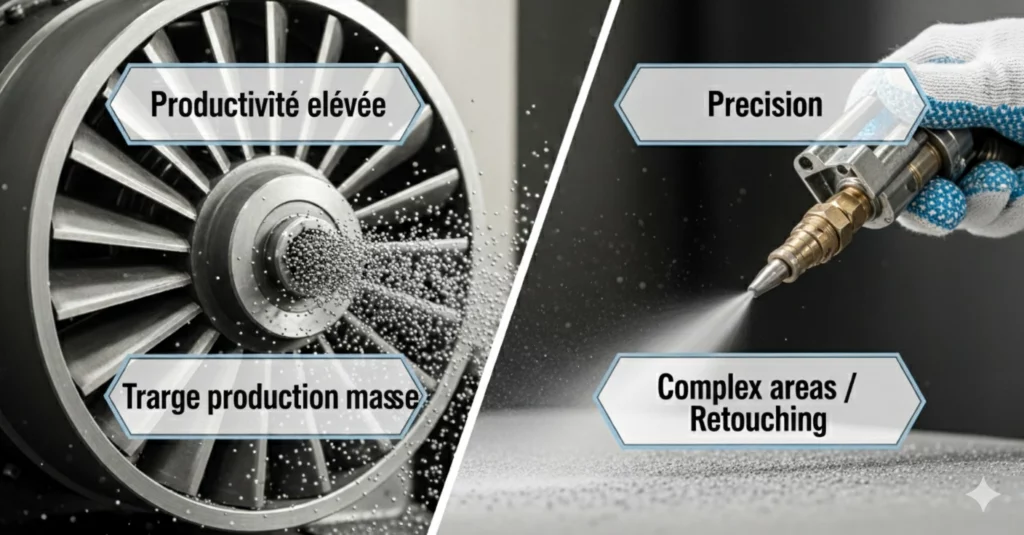
Blasting methods: turbine or compressed air?
Turbine blasting uses a rotating wheel to project abrasives at high speed. This ultra-productive method is reserved for large volumes and bulky parts such as engine blocks. FINISHTECH offers turbines capable of treating surfaces at a rate of 10 to 15 m² per hour.
Pneumatic shot-blasting uses a stream of compressed air to propel abrasives through a nozzle. Although slower, it allows precise control of the angle of impact, essential for complex patterns or sensitive areas. FINISHTECH’s manual blast cabinets feature variable nozzle geometry to optimize finish quality.
Did you know that ultrasonic shot peening, using sonotrode-activated spherical beads, reduces dust production by 60% compared to traditional methods? An innovative solution for sensitive environments.
The 3 stages of shot-blast treatment
1. Preparation: Parts are degreased and inspected for defects. FINISHTECH sensors detect residual contamination to an accuracy of 0.1 µm.
2. Projection: Parameters (speed, flow rate, angle) are adjusted via touch-sensitive interfaces. FINISHTECH’s automated systems guarantee repeatability to within ±2%.
3. Finishing: Final dedusting uses HEPA filters capturing 99.97% of 0.3 µm particles. In one of the most efficient processes for metal surface treatment, this step prepares surfaces for coatings with up to 30% greater adhesion.
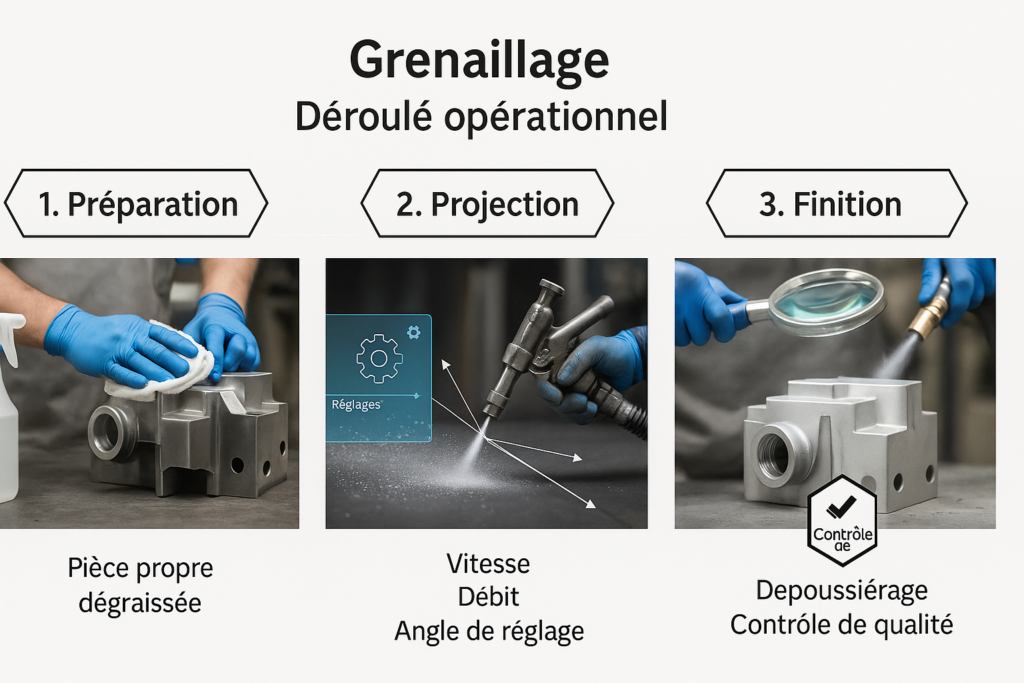
Concrete shot blasting applications by sector and material
Metal processing: aeronautics, automotive and foundries
Shot peening is revolutionizing the durability of critical parts. By projecting metal balls at high speed, this technique creates compressive stresses on the surface, delaying the onset of cracks. According to a thesis by the University of Troyes(thesis 2017TROY0037), this method can increase the fatigue life of aeronautical components by up to 1000%.
In the automotive industry, suspension springs and connecting rods undergo this treatment to withstand millions of cycles without breaking. In foundries, shot blasting eliminates residual sand and burrs, while reinforcing parts prior to integration. In steel construction, it prepares steels to receive anti-corrosion paints, guaranteeing optimal adhesion on structures such as bridges and cranes.
Shot blasting of floors and non-metallic surfaces
For concrete floors, shot blasting effectively removes laitance and adhesive residues, while creating the ideal roughness for epoxy resins. This preparation triples the wear resistance of industrial floors. On roadways, it removes road markings without generating dust, thanks to integrated suction systems such as the SOMAS S320RD model.
Airport runways benefit from renewed grip after decades of wear and tear, while stone heritage regains its lustre and strength through cleaning without aggressive products. Glass and ceramic abrasives provide gentle yet effective cleaning of historic facades, preserving their integrity.
A process with many industrial facets
The versatility of shot blasting is illustrated in these key sectors:
- Naval sector: Ship hulls are decontaminated before the application of antifouling paints, to prevent fouling by algae.
- Railway sector: Wheels and rails are treated to withstand repeated thermal and mechanical shocks.
- Renewable energies: optimized microstructure makes wind turbine blades more resistant to high winds.
- Additive manufacturing: 3D-printed metal parts benefit from an improved surface finish, essential for their integration in aerospace or biomedical applications.
FINISHTECH machines, equipped with centrifugal turbines or ultrasonic technologies, adapt the process to each application. With reduced energy consumption and recyclable abrasives, this approach meets the challenges of sustainability while optimizing industrial productivity.
Blasting equipment and industry innovations
Shot-blasting machines: at the heart of industrial performance
How do you efficiently process a wide variety of metal parts? Finishtech offers shot blast machines with turbines, automated booths and handling systems. Turntable models handle bulk or complex parts, while AGTOS turbines ensure precise blasting. This automated equipment reduces costs and guarantees consistent quality. To choose your ideal machine, discover Finishtech solutions adapted to your production volume.
The importance of dust collection and abrasive recycling systems
Did you know that 30% of a workshop’s costs come from waste? Recycling systems collect, clean and re-inject abrasives, reducing waste by 70% and costs by 40%. HEPA dust collectors filter out 99% of toxic particles, with ATEX certification for explosive environments. These Finishtech technologies ensure clean production and regulatory compliance.
Towards shot blasting 4.0: automation, AI and ecology
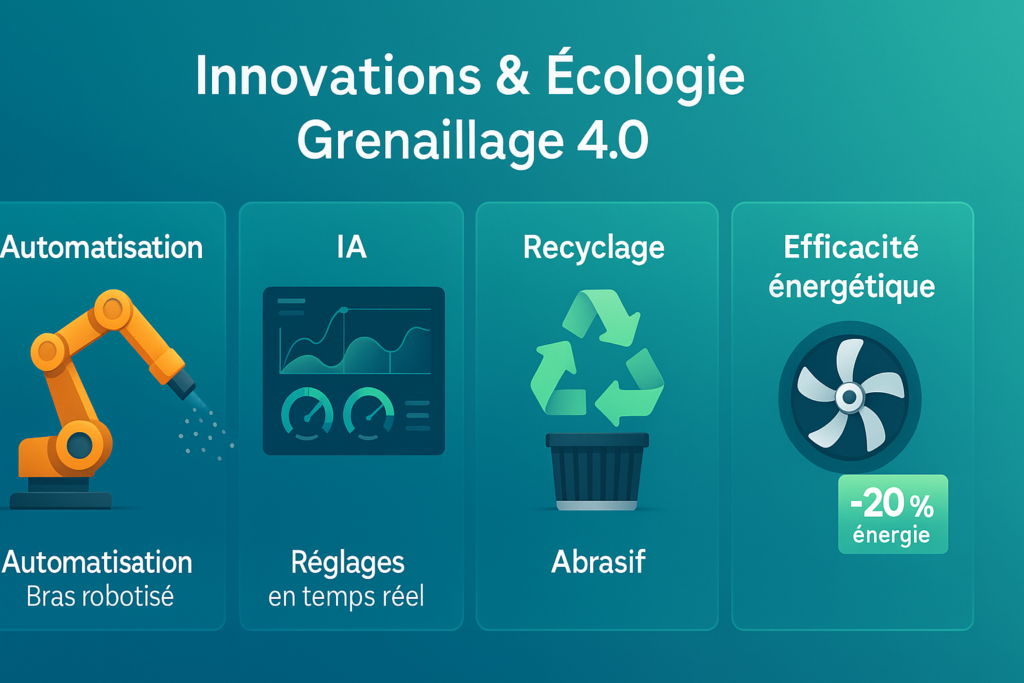
The shot blasting industry is changing. Finishtech anticipates trends with :
- Automation: Robotic arms for uniform coverage of complex geometries.
- AI control: real-time adjustment of speed and impact angle.
- Eco-friendly abrasives: biodegradable or recycled microbeads.
- Energy efficiency: Turbines designed to consume 20% less energy.
These advances position Finishtech as a key partner for high-performance, sustainable workshops.
Safety, standards and best practices for shot blasting
Operator safety: an absolute priority
Shot blasting involves real health risks for operators. Metal dust, noise and shot splashes call for strict measures. Personal protective equipment (PPE) includes an air-supplied helmet, coveralls, cut-resistant gloves and safety boots.
- Rigorous training is essential to master risks and intervention protocols
- Modern machines incorporate containment systems to reduce exposure (INRS standard ED 121).
For companies like FINISHTECH, operator safety is integrated right from the machine design stage. Leak detection systems, optimized containment zones and intuitive interfaces minimize occupational hazards while ensuring efficient material processing.
Understanding quality standards: Almen intensity and recovery rate
Two key indicators guarantee the quality of shot peening: Almen intensity and recovery rate. These parameters ensure optimum resistance of parts to mechanical stress.
- Almen intensity measures the energy transmitted by the shot via metal specimens (Almen SAE1070 blades) subjected to the blast.
- The recovery rate indicates the percentage of the surface impacted: a minimum of 100% is required, with PEENSCAN® checks for complex areas.
Standards define verification protocols such as Almen saturation (arc curve) and automated real-time monitoring systems (e.g. SmartPeen®). These checks prevent hidden defects and guarantee process repeatability. FINISHTECH offers machines incorporating these control technologies to ensure complete traceability, with automatic reports at the end of each processing cycle.
Shot blasting, a surface treatment technique, combines cleaning, preparation and mechanical reinforcement via the projection of abrasives. Preferred in the automotive, aeronautics and construction industries, it improves the durability of parts and the adhesion of coatings, and can be adapted to a variety of materials. Innovations in automation and ecology make it an indispensable method for demanding industrial applications.
FINISHTECH is not just a supplier, but also a strategic partner for your competitiveness.
With our proven solutions, you can be sure of a flawless finish, optimum productivity and a reduced environmental footprint.
Contact us today for a free quotation
We’ll be there to help you with your finishing projects